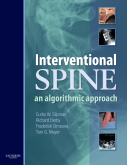As many as 80% of patients will suffer from back pain at some point
in their lifetime. It is the most common form of disability, and the
second largest cause of work absenteeism. An early, proactive
management approach offers the best route to minimizing these
conditions. Renowned authority Curtis W. Slipman, MD and a team of
multidisciplinary authorities present you with expert guidance on
today’s best non-surgical management methods, equipping you with the
knowledge you need to offer your patients optimal pain relief.
----------------------------------------------------------------------
----------
목차
차 례
List of Contributors
Dedication
Acknowledgements
Part 1 General principles
Section 1: Introduction
1. Past, present and future of interventional physiatry
2. Epidemiology
Section 2: Spinal pain
3. Inflammatory basis of spinal pain
4. Transduction, transmission and perception of pain 5. Central
influences on pain
Section 3: General diagnostic technique
6. Radiology
7. Nuclear medicine imaging with an emphasis on spinal infections
8. Electrodiagnostic approach to patients with suspected
radiculopathy
9. The psychiatric and psychological evaluation of the chronic pain
patient
Section 4: Practical pharmacology
10. Nonsteroidal antiinflammatory drugs
11. Adjuvant analgesics for radicular pain
12. Pharmacology of local anesthetic agents
13. Steroids in spine interventions
14. Opioid analgesics
15. The diagnosis and treatment of anxiety disorders in chronic
spinal pain
Part 2: Interventional spine techniques
Section 1: Principles and concepts underpinning spinal injection
procedures
16. Principles of diagnostic blocks
17. Neurophysiology of diagnostic injections
18. Placebo
19. Patient education and support
20. Side effects and complications of injection procedures:
anticipation and management
21. Radiation Safety ? Theory and Practical Concerns 22. Sedation for
percutaneous procedures
Section 2: Interventional spine techniques
23. Spinal injections
24. Technique of radiofrequency denervation
25. Discography
26. IDET technique
27. Technique for chemonucleolysis of lumbar disc herniation
28. Automated percutaneous lumbar discectomy: technique
29. Laser
30. Spinal cord stimulation for chronic pain management implantation
techniques
31. Intrathecal therapies and totally implantable drug delivery
systems
32. Vertebroplasty
33. Kyphoplasty technique
Part 3: Specific disorders
Section 1: Medical spinal disoders
34. Medical Radiculopathies
35. Spondyloarthropathies
36. Spine Infections: an algorithmic approach
37. Nonosseous spinal tumors
Section 2: Osseus spinal tumors Subsection i: Physiology and
assessment
38. Bone biology
39. Osteoporosis
40. Paget’s disease
41. Secondary Bone Tumors
42. Primary Tumors Subsection ii: Treatment
43. Spinal Orthoses
44. Vertebroplasty
45. Kyphoplasty
Section 3: Cervical Spine Subsection i: Anatomy and assessment
46. Developmental and functional anatomy of the cervical spine
47. Medical causes of neck pain
48. Examination of the cervical spine
49. Biomechanics and assessment of the painful shoulder
50. Cervical myelopathy
51. Cervical instability Subsection ii: Whiplash
52. Biomechanics of the cervical spine during whiplash injury
53. Pathophysiolgic evidence of injury
54. Sociocultural evidence and whiplash
55. Soft tissue injuries following whiplash
56. Epidemiology of disc, joint and root pain in whiplash Subsection
iii: Treatment Subsubsection i: Cervical radicular pain
57. Cervical radicular pain: an algorithmic methodology
58. Rehabilitation methods in cervical radicular pain
59. Cervical radicular pain: injection procedures
60. Surgery for cervical radicular pain
61. Surgical decompression for foraminal stenosis Subsubsection ii:
Cervical axial pain
62. An algor


